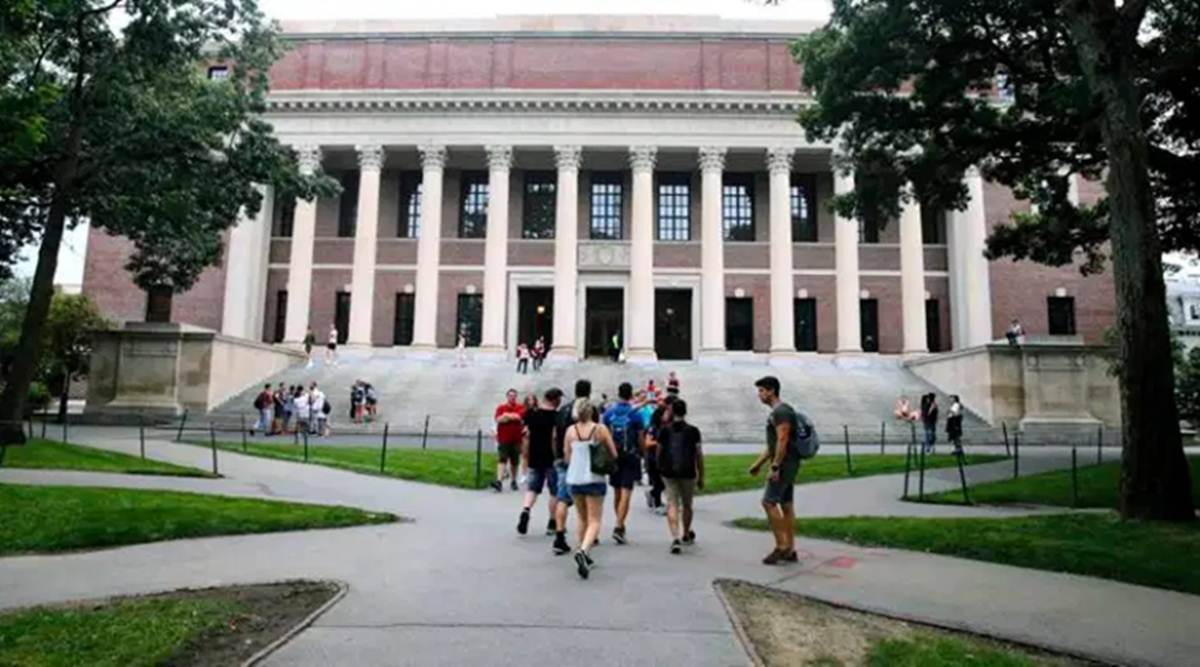 Students walk near the Widener Library in Harvard Yard at Harvard University in Cambridge. (File/Reuters)
Students walk near the Widener Library in Harvard Yard at Harvard University in Cambridge. (File/Reuters)Now that Donald Trump has been shown the EXIT sign, we may be able to enjoy the Netflix series, Trump: An American Dream, without an immediate sense of doom. The series reveals the enormity of the deception behind the rise of a populist dictator. How does a Manhattan real-estate tycoon, who almost exclusively dealt in uber-luxury high-rises and casino dens, toying with 24-carat-gold cutleries in a private jet surrounded by Playboy models, end up as the champion of the working class?
The answer to this is simple: Trump’s hatred of higher education. “I love the poorly educated” – he’d declared during the 2016 primaries — and that became his battle cry around a nationwide band of disgruntled white voters reeling under the “humiliation” of a highly-educated Black president for eight years.
Is populism anti-intellectual? It is hard to make a large claim. As the Marxist scholar Terry Eagleton says, when it was found that Nazi administrators of the Holocaust liked to while away their time outside gas chambers with Wagner operas, it seemed that defenders of high culture had some serious explaining to do.
The more urgent question to ask now is whether the popular suspicion of higher education in the US is now deep and wide enough not only to power deceptive populism, but to have far-reaching policy implications no matter who is in power. Given the history of the American university, this is deeply ironical.
Unlike the universal and cosmopolitan ambitions of the medieval European university, the origins of the American university system were humble, parochial and deeply local. “The American college in the nineteenth century,” writes the education historian David Labaree, “was a hometown entity.” In a land of multiple and competing church denominations, founding a college was an effective way to “plant the flag and promote the faith”. Likewise, a college was a solid claim for a sleepy country town to get on the map so that it could demand a railway stop, the county seat, or even the state capital, and, in turn, to raise the value of local real estate. The founding history of American colleges continues to live in their deep community engagement — manifested most strikingly through their commitment to collegiate sports and local alumni support.
Notwithstanding its local and community roots, even in the early 20th century, college was a likelier choice for the wealthy, which made up the Republican party. People supporting the Democratic party were mostly labourers and wage-earners, people far less likely to attend college. An aristocratic oligarchy defined the faculty for long after. When I started teaching at Stanford in 2007, a senior professor, a Yale graduate, shared the story that back in the ’60s and ’70s, new Yale professors were anxiously asked by their senior colleagues: “I hope you have a trust fund? Surely you don’t have to actually live on the salary?”
But the demotic spirit of the American university has been historically resilient, bolstered by a few landmark policy measures: The 19th-century establishment of the land-grant college, which offered training that sought to address everyday problems of the local community, and in the 20th century, the GI Bill sponsored college education for a wide range of war veterans, including many from poor and working-class backgrounds. Soon thereafter, the baby-boomers flocked to college, and that too primarily from blue-collar backgrounds.
Higher education was no longer the exclusive provenance of the wealthy, though the elite bastions remained — say the fabled Andover-Yale network, through which an academically mediocre George W Bush could rise to political power. But, at the same time, a perceived radicalisation of the universities and the consequent culture wars began to energise a conservative backlash against higher education. The fear of the university classroom as a venue for dangerous liberal ideas — a suspicion that would be well-understood in India today.
But the current suspicion of higher education does not come so much from conservative ideologues, who have also had their high-philosophical champions, probably most notably in Allan Bloom’s influential The Closing of the American Mind. It comes rather from a wide swathe of poor and blue-collar whites, who feel excluded and disenfranchised by the process of globalisation. Beginning with the depletion of the manufacturing industries in the rust belt — traditionally blue states that have gone swing — they reached a climactic outburst of anger in 2016, leading to the Trump victory exactly as a similar rage polled Brexit to victory.
It is the great irony for a nation that created land-grant colleges and the GI Bill that now the working class basically means people without a college degree, irrespective of people who are wage labourers. Plenty of space for an anti-intellectual billionaire television populist to insert himself as a champion of the working class!
Either way, 2016 feels like a watershed year. According to a poll conducted by the Pew Research Center, a majority of people from both parties had a positive view of colleges in 2015. But in 2016, only 43 per cent of Republicans held that view, compared with 72 per cent of Democrats. Most recent polls have shown sharper concerns about higher education from supporters of both parties — and what is, perhaps, the greatest concern to Americans across the board — the impossibly escalating cost of college.
A deep suspicion of the university is now a key reality in what is being described as the Divided States of America. In it are the seeds of suspicion of much else: Globalisation, immigration, the cosmopolitan life of the mind, responsibility for the environment.
Of science, yes. And, at this pointed moment of political relief, the urgency of the mask!
The writer is professor of English & creative writing at Ashoka University